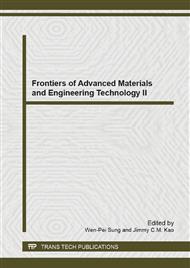[1]
Arthur Cecil Pigou. The Economics of Welfare [M]. London: Macmillan Company, (1920).
Google Scholar
[2]
TANG Xiao-wo. Study of Maximum Condition of Monopoly Revenue in Case of Second Degree Price Discrimination[J]. Journal of University of Electronic Science and Technology of China, 1997, 26(2): 194-198.
Google Scholar
[3]
TANG Xiao-wo. Study of Second Degree Price Discrimination under Condition of Non-linear Demand Function[J]. Journal of University of Electronic Science and Technology of China, 1999, 28 (1): 78-83.
Google Scholar
[4]
TANG Xiao-wo. A Further Study on the Second Degree Price Discrimination [J]. Journal of Management Sciences in China, 2001, 4(1): 7-11.
Google Scholar
[5]
CHEN Shao-gang, TANG Xiao-wo, ZHAO Shu-rong. Nash Equilibrium of Second Degree Price Discrimination under Two Manufacturers[J]. Systems Engineering-Theory Methodology Application, 2003, 12(4): 303-306.
Google Scholar
[6]
CHEN Shao-gang. On Theoretical Extension of Two Methods of Price Differentiation[D]. University of Electronic Science and Technology of China, (2004).
Google Scholar
[7]
GAO Xing-you. Static and Dynamic Games of Oligarchic Enterprises on Second Degree Price Discrimination[J]. Journal of Qujing Teachers College, 2003, 22(6): 25-28.
Google Scholar
[8]
GAO Xing-you. The Mathematical Economics Analysis on Second Degree Price Discrimination [D]. University of Electronic Science and Technology of China, (2003).
Google Scholar
[9]
CHEN Shao-gang, GAO Xing-you, TANG Xiao-wo. Further Study on Second Degree Price Discrimination Equilibrium under the Competitive Circumstance[A]. Proceedings of 2005 Chinese Control and Decision Conference [C], Harbin: Heilongjiang University Press, 2005: 1726-1728.
Google Scholar
[10]
GAO Xing-you, GAO Wen-jin. Nash Equilibrium of Second -Degree Price Discrimination inOligopoly Market[A]. Proceedings of 2012 International Conference on Computer and Management [C], Dover: Scientific Research Publishing, USA, 2012, Vol. 2: 783-788.
Google Scholar
[11]
GU Jing, CHEN Shao-gang. Analysis on Multi-Manufacturer Second-Degree Price Discrimination Action Based on the Cournot Model[J]. Journal of University of Electronic Science and Technology of China, 2007, 36(2): 470-472.
Google Scholar
[12]
GAO Xing-you, GAO Wen-jin. Equilibrium Output and Price of Four Kinds of Markets under the Condition of Price Discrimination[J]. Journal of Quantitative Economics, 2011, 28(1): 81-84.
Google Scholar
[13]
TANG Xiao-wo, FU Chong-lun. The Study of the Effectiveness of Price Discrimination[J]. Journal of University of Electronic Science and Technology of China, 1996, 25(2): 200-205.
Google Scholar
[14]
TANG Xiao-wo. Quantitative Analysis of the Third Degree Price Discrimination[J]. Journal of Industrial Engineering and Engineering Management, 1999, 13(1): 37-39.
Google Scholar
[15]
WANG Wei. The Studies on Third-Degree Price Discrimination and Its Welfare Effectiveness[D]. University of Electronic Science and Technology of China, (2005).
Google Scholar
[16]
WANG Wei, CHENG Shao-gang. Study of the Effectivity of Third-Degree Price Discrimination under Two Manufacturers[J]. Journal of University of Electronic Science and Technology of China, 2007, 36(S1): 482-484.
Google Scholar
[17]
TANG Xiao-wo, ZENG Yong, LI Shi-min. Analysis on Management Economy — Theory and Application[M]. Chengdu: University of Electronic Science and Technology of China Press, (2000).
Google Scholar
[18]
Tirole. Industrial Organization Theory[M]. Beijing: Renmin University of China Press, (1997).
Google Scholar
[19]
GAO Hong-ye. Western Economics (4th edition) [M]. Beijing: Renmin University of China Press, (2007).
Google Scholar
[20]
Paul Samuelson, William Nordhaus. Economics (16th edition)[M]. Beijing: Huaxia Publishing House, (1999).
Google Scholar
[21]
ZHANG Wei-ying. Game Theory and Information Economics[M]. Shanghai: Shanghai joint publishing company LTD, Shanghai People's Publishing House, (1996).
Google Scholar
[22]
XIE Shi-yu. Economic Game Theory(2nd edition)[M]. Shanghai: Shanghai joint publishing company LTD, Fudan University Press, (2002).
Google Scholar


